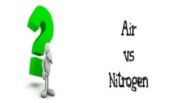Nitrogen or air? Which is better for your car’s tyres? Know here.

There are many things which depend upon the health and condition of tyres of your car. For safety and mileage, people give extra care to tyres. You may have heard of people filling Nitrogen in their car tyres instead of regular air and wondered how it helps. Some say it prevents tyre bursts, while others claim that mileage increases. Here we take a look at the pros and cons of filling Nitrogen in your tyres and whether it makes sense for you or not.

What nitrogen does?
There are multiple factors that make Nitrogen more suitable as a tyre inflating gas. The primary reasons are it is less likely to escape the tyre’s rubber as against Oxygen. That means your tyre pressure will remain the same for much longer periods. As a result you won’t have to make frequent stops to fill air in your tyres.
Nitrogen also displays less pressure change with altering temperatures as against Oxygen, giving you consistent air pressure. It helps enhance the handling of your car as the pressure can now be controlled down to the last PSI. Nitrogen also resists moisture much better than Oxygen (for obvious reasons!).
Hence the chances of your rim getting rusted are far lower if you use Nitrogen, as it has next to no water content. More constant pressure also means that your tyre maintenance costs will drop along with fuel expenses.
Nitrogen & tyre bursts
Tyre bursts occur mainly due to the tyre running at lower pressure than recommended, at high speeds. Since nitrogen stays in the tyre longer than regular air, the chance of the tyre losing pressure is lower when it’s filled with nitrogen. Moreover, it helps the tyre run cooler, which means that high speed runs cause less stress on a tyre filled with nitrogen as compared to one filled with regular air.
Should the tyres be inflated with Nitrogen?
After reading of all the benefits of Nitrogen you may feel like you need it but not necessarily! Nitrogen is generally used to fill tyres of race cars and airplanes. That is because the tyres of both race cars and airplanes need to function at very high temperatures. A race car driving at exceptionally high speeds will produces a lot of heat at the tyre and regular Oxygen wouldn’t work well at those temperatures. Similarly airplane tyres need to have the perfect air pressure and handle similar levels of heat.
In our everyday passenger cars which spend more time stuck at stop lights than in top gear, Nitrogen filling is not very relevant. This is because even the regular air you will from a petrol pump is 78% Nitrogen, 21% Oxygen (plus other gasses which we can ignore).
Secondly if you keep your tyres pressure under check and fill air in it regularly then you will get the same benefits of better fuel efficiency and handling. It is more about the tyre air pressure than the gas that you use to inflate the tyre. Read more: Tyre buying guide: What type and brand to choose?
But if you one of those who drives frequently on the highway, at high speeds during the daytime, filling nitrogen in your car’s tyres will prove to be beneficial as it helps the tyre stay cooler, and prevents tyres from losing pressure frequently.
Last but not the least Nitrogen tyre filling will cost you money, while air is…well free! So no matter how many times you have to fill air it will cost you exactly Rs.0. So the only true benefit of Nitrogen tyre filling is that you will save time.
The crux
Filling Nitrogen in your car tyres will cost you about Rs.10-20 (depending upon the inflating point) per-tyre which means Rs.40-80 per-car including the cost of filling the spare. If you are not an enthusiast and won’t really be driving much outside the city stick to regular air. If you feel that you would rather spend Rs.40-80 on inflating your tyres than standing in a queue to get regular air filled, then and only then does Nitrogen filling make a little sense.

 Currency Convertor
Currency Convertor Post an article
Post an article Aman Attri
Aman Attri

 sending...
sending...




